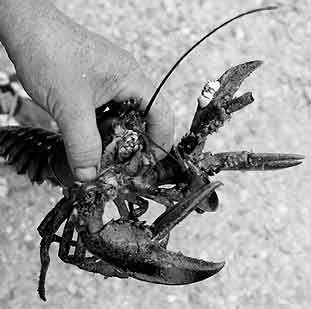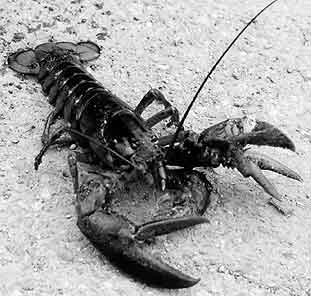 |
 |
Robin Dunham and his sternman Roger Eaton found this four-clawed lobster in a trap while fishing gear off Stonington, ME in July.
Commercial Fisheries News - October 2000
Normally, lobsters develop claws of two types: the bulkier crusher claw bears large molar-like teeth while the seizer has sharp incisor-like teeth. During claw differentiation, there is a 50:50 chance of developing a right- or left-crusher depending upon which claw is used more frequently. Later in life the crusher claw becomes sexually dimorphic. Reproductive males develop a disproportionately large crusher claw that females find irresistibly attractive.
Occasionally, a lobster with more than two claws is landed. Repetition of body parts occurs in segmented animals such as lobsters and insects. Each body segment has a particular set of regulatory genes that tells the animal which appendages to grow on that part of the body. Abnormalities arise when the regulatory genes give the wrong signal.
The lobster in the accompanying photos was landed by Robin Dunham at Stonington, ME. On her right side, this female lobster has a normal seizer claw. On the left, she has a smaller, normally functioning crusher claw. That in itself is not particularly unusual. Lobsters often lose and regenerate claws. It can take many molts for the smaller claw to catch up in proportionate size.
But that is not what is happening in this case.
 |
 |
There are several characteristics that make the lobster in the photos extremely unusual. The most obvious abnormality is that there are three claws on one side. Taking a closer look, notice that there is a “double seizer” growing out of the same body segment as the crusher. The presence of the double seizer, though, is not nearly as rare as the condition of having more than one claw attached at the main body segment. The crusher and the double seizer are both attached directly to the main body.
Claw abnormalities usually originate at a joint near the end of the claw — as in this double seizer. The top left seizer has two barnacles growing on it. The bottom left seizer is upside down. While not apparent in the black and white photo, the bright orange of the claw bottom shows on top.
The genetic code for the body segment where the three claws originate gave two sets of instructions for the developing claw on the left side. Further, out on the double seizer at yet another segment, the regulatory genes have ordered the creation of two sets of pinchers.
This lobster has most likely had three claws branching out of its left side throughout life. However, it is possible for developmental changes to occur during regeneration.
The prevalence of such curiosities in nature is not well-known. The claws are important survival tools for lobsters. Therefore it is unlikely that many lobsters with similar handicaps grow to marketable sizes.